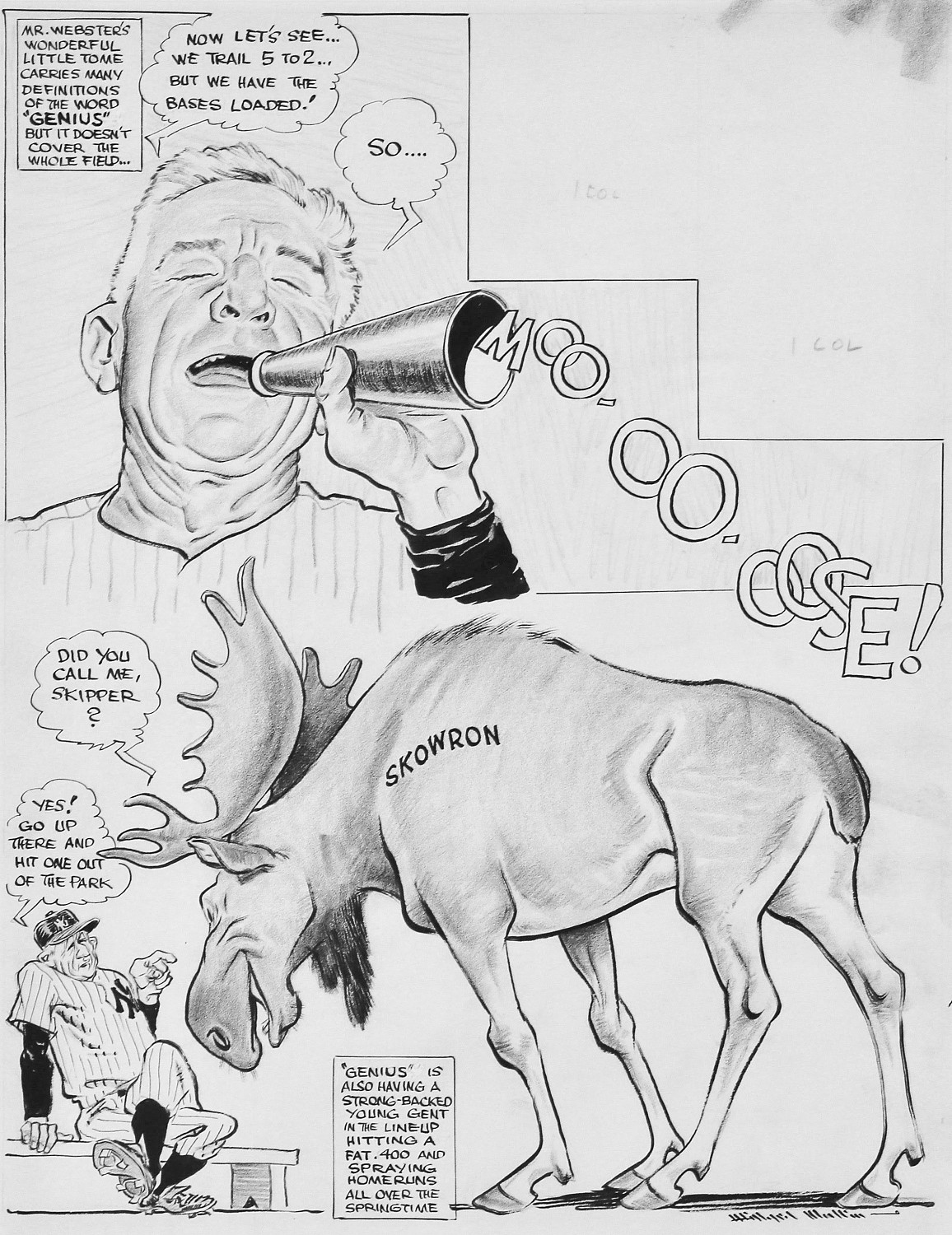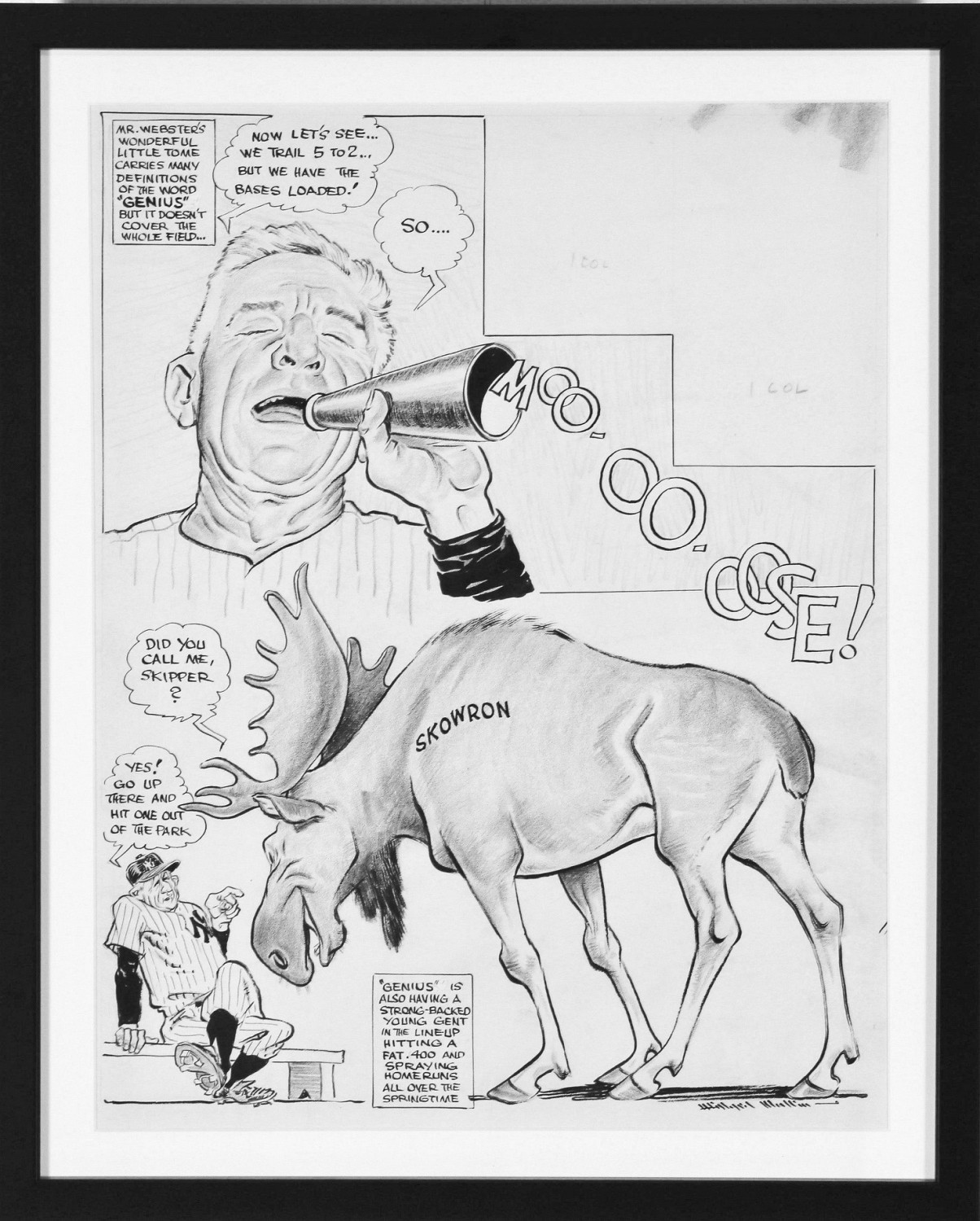"Moo-oo-oose! " Lot no. 3654
By Willard Mullin (1902-1978)
13.5" x 17.5"
Ink and crayon over graphite on Board
Signed Lower Right
REQUEST PRICE
PURCHASE REQUEST
The medium of this artwork is ink and crayon over graphite on pebble-grain Coquille board, with blue-pencil background shading.
Mullin, one of the greatest sporting cartoonists, casts an admiring eye on Bill Skowron, the first baseman who served the New York Yankees from 1954-67 as a homerun champion. Skowron's childhood nickname, Moose, stuck with him through a distinguished career. Mullin also delivers two portraits of Yankees chief Casey Stengel -- one photorealistic close-up, and one caricature.
Explore related art collections: Black & White / Sports / $100 - $5,000 / Baseball / Comics/Cartoon
See all original artwork by Willard Mullin
ABOUT THE ARTIST
Named "Sports Cartoonist of the Century" by the National Cartoonists Society -- he was the Rembrandt of the sports pages during the glory years of sports cartooning.
The "Sports Cartoonist of the Century" honor came in 1971, after both newspaper sports cartooning and Mullin had retired. By then, the New York newspaper for which Mullin created cartoons six days a week for 33 years, had closed.
Willard Mullin and sport cartooning were born the same year, 1902-- Mullin on a farm near Franklin, Ohio, and sports cartooning beside a boxing ring in San Francisco. Young Willard knew from an early age that he wanted to be a cartoonist. When his seventh grade teacher sent him to the principal's office for drawing in his text books, the principal asked: "What's to become of you?" Young Mullin answered that he was going to become a sports cartoonist.
After high school, he took jobs that would give him the experience he believed he needed. He learned rapid lettering in the sign shop of Bullock's department store. Starting as an apprentice in the art department of the Los Angeles Herald, he learned to retouch photos with wash and brush which gave him skill with the ink washes he used in his cartoons.
Practical experience built on his innate sense of composition. "A sense of composition is like an ear for music," he later said, "I believe I had it." Mullin was recruited as a sports cartoonist in 1934 by the New York World Telegram, a Scripps-Howard paper. He believed a sports cartoonist was like a sports columnist, "delivering the news, but also editorializing, commenting and either applauding or stabbing." He covered the events and executed his own ideas.
Mullin's most famous character, the Brooklyn Dodger Bum, was born in 1937 as a taxi driver took Mullin back to the office after a Dodgers baseball game at Ebbets Field. The driver asked: "How'd our bums do today?"
He created figures to symbolize other teams. For a Time magazine cover, he drew the New York Mets as a little kid - the new team in town that won the pennant in 1969. The New York Giants was the huge, amiable hulk; the Yankees, clinical professionals, and the St. Louis Cardinals, Swifty, the riverboat dandy.
Some sports were easier to draw, according to Mullin. Prize fighters were his favorite subjects because, "they are completely basic. Boxing action practically draws itself." He watched Joe Louis fight 25 times -- and there are six Joe Louis cartoons in the National Art Museum of Sport. In addition to the some 10,000 cartoons for the World Telegram, Mullin's work also appeared in Sporting Week, the Saturday Evening Post, other magazines, books, and advertisements. In 1971 he and his wife Helen moved to Florida. He died in 1978 in Corpus Christi, Texas.
It is estimated that at least a third of Mullin's original cartoons were given to sports figures or fans. About 300 are in the manuscript collection of the library at Syracuse University. One hangs in the Metropolitan Museum of Art.
The 30 original Mullin cartoons in the National Art Museum of Sport were given to the Museum by his daughter Shirley Mullin Rhodes of Corpus Christi and the late David Camerer of New Canaan, Conn., who as a sports writer was a colleague of Mullin. Camerer co-wrote Mullin's autobiography, A Hand in Sport.
The Museum also was given the trophy Mullin prized most: the Rube Goldberg-designed Reuben he was awarded in 1955 as Cartoonist of the Year.
Biography from The National Art Museum of Sport, Inc.



